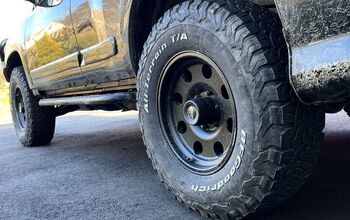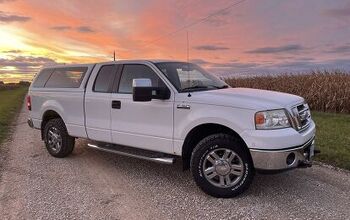BFGoodrich All-Terrain T/A KO3 Review: Like The KO2, Only Better

Alaska has, without question, one of the most ruggedly beautiful landscapes in North America. From its numerous glacial lakes and rivers, dense forests, and mountain ranges, which include Denali, the tallest mountain in North America. Alaska is an adventurer’s dream.
It is also a spectacular setting for overlanding, especially with a sturdy set of tires underneath your off-roader. BFGoodrich picked Alaska, specifically the small village of Talkeetna located about two hours north of Anchorage, to put its all-new All-Terrain T/A KO3 tire, the replacement for the brand’s legendary KO2, to the test.
The KO3 soft-launched in May and has seen many popular sizes added in the months since. These tires have big shoes to fill. This writer was at the Canadian launch of the KO2 in the fall of 2014, and noted, "The KO2 performed admirably over broken ground on off-road trails and lake beds.” The tires also, "handled obstacle (rocks) with little drama.”
I’ll get to our Alaska KO3 off-roading experience shortly, but first a bit of BFGoodrich off-road history.
History Of Racing Dominance
BFGoodrich has been a pioneering off-road tire company for almost 50 years, dating back to the launch of the world’s first all-terrain tire in 1976.
Motorsports has proven to be a valuable laboratory for BFGoodrich engineers which have used 20 race wins at the Dakar Rally to improve technology used in their street tires. For instance, CoreGard Technology, which has produced tougher sidewalls, was derived from the company’s Baja T/A KR3 racing tire used in the Baja 1000, a punishing 1,000-mile off-road race in the Baja California peninsula that BFGoodrich has won 33 times.
For the KO3, a third-generation all-terrain that began with the introduction of the original KO in 1999, BFGoodrich put it through a punishing development cycle that included various prototypes used by its motorsport teams in Baja races.
The KO3
The result? A tire that builds on the toughness and durability the KO2 is known for, but with new features with a renewed focus on BFGoodrich’s three Ts: treadwear, toughness, and traction.
On the treadwear front, the KO3 features a new all-terrain compound designed to deliver longer life, both on and off-road. It also has an optimized footprint that’s built to distribute stress for more uniform wear. Lastly, the KO3 has 3D locking sipes for better tread block stability and even wear.
In terms of toughness, CoreGard Technology played a key role in the development of split and bruise-resistant sidewall rubber, while advanced deflection design helps protect the sidewall from being snagged or split by protruding objects, such as sticks and stones. Shoulder rubber that extends further down the sidewall also helps puncture resistance.
For traction, the KO3 is designed for improved performance in snow and mud. Key features include an updated serrated shoulder design, which includes “Mud Phobic Bars” and Interlocking Tread Elements, which stabilize the tread center and provide biting edges for off-road traction. Full-depth 3D locking sipes and mud/snow notches also aid in traction, which allows the KO3 to be Severe Snow Rated. As a result, the tire carries the three-peak mountain snowflake symbol.
Our Off-Road Vehicles
To tackle the Alaskan wilderness, BFGoodrich, in partnership with Alaska Overlander, a local tour operator, mounted KO3s on a fleet of Toyota and Lexus vehicles. They were mostly current gen 4Runners, with a few older Tacomas, Lexus GXs, along with a Nissan Frontier, in the mix. What caught the eye of myself and a colleague the day before our drive, however, was an 80 Series Land Cruiser. We were determined to drive this vehicle and, spoiler alert, we did.
The Route
Our off-road route, which would take us to the edge of Denali State Park, took about 45 minutes to reach, as it was located northwest of Talkeetna.
Much of the route to the trails was on pavement, and my driving partner and I noticed how quiet the KO3 tires were on our 4Runner test vehicle. At speeds that ranged from 45 to 60 mph (72 to 97 km/h), the KO3s didn’t emit much road noise and delivered a comfortable ride.
Closer to the trails, pavement turned to dirt and gravel, but once again, the KO3s didn’t make much noise. Sure, the ride was rougher due to the surface change, but the BFG rubber felt comfortable, with good traction and a relatively smooth ride.
The Trails
Before heading out onto the trails, we stopped at Fork’s Roadhouse for refreshments and the last chance to use indoor plumbing.
After that, off we went. First stop: a trek down mud loop road, which was a deep and muddy trench filled with water. Side note: September tends to be a high rainfall month in Alaska and, apart from our arrival day on Friday, it rained during most of our visit, which made for drenched trails.
At any rate, the KO3s made short work of mud loop road, with impressive biting action from the tread pattern that helped power our 4Runner through mud that was about a foot deep.
After that, we traveled to a sand pit area that had been deluged with so much water it looked like a small lake. I was a bit nervous about driving through it as I wasn’t sure how deep it was, but our instructors assured us our KO3-equipped vehicles could handle it.
And they did. I descended down a steep hill before plunging into standing water that must have been upwards of two feet deep, but the KO3s powered through it with ease. I ran the course twice, once across the widest part of the pond, and the second up a muddy hill, and was impressed by the KO3’s traction.
From there we drove further north over some very narrow and rocky terrain which, in some cases, was only wide enough for one vehicle at a time. On several occasions we drove 20 – 30 feet through rocky creeks and streams that made me a bit nervous. Initially, I wasn’t sure if we would make it through, but each time the KO3s gripped up to help power us through. There were no official depth readings, but I estimate the depth to be between 12 and 18 inches.
Trail’s End: Denali Overlook
Our overlanding ended at the Denali Overlook, near the entrance to Denali State Park, where we assembled the vehicles, and ourselves, for some group photos. After encountering high winds and biting sleet, the sun finally began to break through as we were descending. Sadly, the low ceiling and overcast skies denied our group a view of the Denali peak. Next time.
Not being able to see Denali was a bit of a bummer, but being able to pilot the 80 Series Land Cruiser back to Fork’s Roadhouse was a highlight for yours truly. This 1997 copy was mostly original, apart from a suspension lift, and I delighted in experiencing its peppy FZ straight-six engine, and incredibly tight retro ‘90s interior, as we bounced over rocks, and through streams and mud. If I ever move to Alaska, this is my ride. With a fresh set of KO3s, of course.
BFGoodrich All-Terrain T/A KO3
Verdict
The BFGoodrich All-Terrain T/A KO3 is available across North America in 30 sizes, ranging from 16 to 22 inches. Five additional 22-inch sizes will go on sale in October. The KO3 comes with a 50,000-mile (80,000 km) limited treadwear warranty for all sizes.
BFGoodrich has a well-earned reputation for being a leader in all-terrain tires, and they have loads of Baja and Dakar wins to prove it.
The KO3, with its improved technology and tougher construction, is made for the roughest overlanding you can throw at it, but it’s just as suitable for everyday driving on pavement. It’s the ultimate go-anywhere tire, worthy of the KO name.
Become an AutoGuide insider. Get the latest from the automotive world first by subscribing to our newsletter here.

With more than 20 years of industry experience, which includes automotive retail, motorsports PR, and writing and editing for various automotive publications, Lee is an AutoGuide freelancer, and car guy to the core. For nearly a decade and a half, he has married his two consuming passions together – journalism and the automotive industry. Whether it’s providing coverage on debuts from an auto show floor, writing road test reviews, or previewing a new model coming soon, Lee is eager to share his passion for the automotive industry with his readers. He is a long-standing member of the Automobile Journalists Association of Canada (AJAC) and won a feature writing award in 2018.
More by Lee Bailie










































Comments
Join the conversation